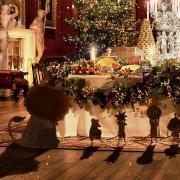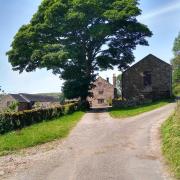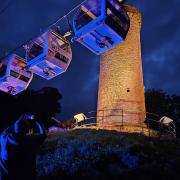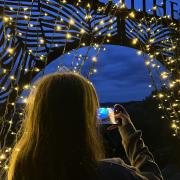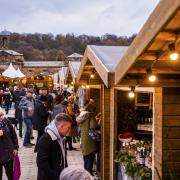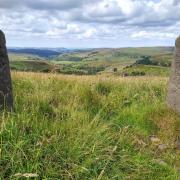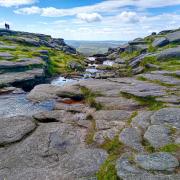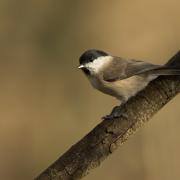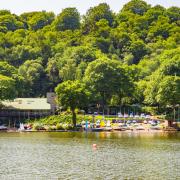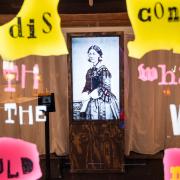The parks and nature reserves in and around Derby are small oases of green and tranquillity away from the city noise.
These three rambles are great for people who can manage only short distances with no obstacles (such as stiles) and for Derby dwellers who find it difficult to access the countryside

Allestree Park
With 320 acres to explore, you can enjoy a short amble around the lake (following the green nature trail) or take a longer ramble around the periphery of the park with its mature woodlands (following the purple woodland trail).
At the park’s centre lies Allestree Hall, once a fine stately home, but sadly looking the worst for wear nowadays. It's for sale if you have a spare penny or two!
Bache Thornhill instigated the construction of the present building in the early 1800s, completed by John Giradot, the High Sheriff of Derbyshire.
The golf course that replaced the parkland has more recently given way to an ambitious rewilding project, a wildlife oasis on the edge of Derby’s urban sprawl much appreciated by Derby’s residents.
Nature is increasingly thriving in the council-owned park, mown grass yielding in summer to long sedges and grasses where insects can thrive. The restored and healthier lake is home to increasing numbers of waterfowl.
This 1.8-mile ramble will blow the cobwebs away. Choose a bright summer’s day, bring a blanket and picnic and spread out in the grasslands with a view of the lake, the hall or Derwent Valley.
Starting from the car park (free) at the end of Saul Lane (off the A6), follow the signed green and purple trails through woodland.
Soon you will reach the lake. Curve round it to walk between handsome villas and the water. Pause at the platform on the west corner to enjoy the birds on the island and in the water. The noticeboard will help you identify the wildlife. Expect to see Canada geese, moorhens, mallards, swans and much more besides.
At a fork, take the path to the right that heads up to Allestree Hall. Where the path divides again, follow the sign for the toilets. On reaching the hall cut through to the formal garden with its flowerbeds, miniature hedges and ornamental pond, the house an imposing sight above it.
Returning to the main path, pass the side of the house and outbuildings (containing the toilets if required) and continue to a crossroads of paths.
Turn right to follow the path as it snakes through the grounds. This is a particularly tranquil part of the walk, the little brook babbling quietly in the valley below.
Soon you will hit Saul Lane. Turn right to climb up to the car park again to complete this gentle 1.8-mile amble.

Darley Park
This 3.3-mile nature and culture walk starts from Darley Park Drive. There’s a free car park close to the park entrance. Alternatively, take advantage of the £2 fares presently on offer and hop on the bus to the Mileash Lane stop.
From Darley Park Drive turn right just before the park gates and lodge house to follow the broad path along the perimeter of the park. It drops down to meet Darley Grove, the leafy park on your left side, garages and housing on your right.
Continue straight onto North Parade, then Darley Lane. At its end veer right to climb the steps to the imposing St Mary’s. It’s worth popping into this Gothic Revival church, if open. The panelled roof of the chapel is particularly lovely.
Directly opposite the church, St Alkmund’s Way Footbridge leads to King Street. Cross by the lights and continue straight onto Queen Street.
Having visited St Mary’s, don’t miss Derby Cathedral with its unusual interior and gorgeous wrought-iron chancel screen. The original 1500s tower is still intact, but the church was rebuilt to a neo-classical design in the 1700s.
Unlike many cathedrals, it’s light and airy with a simple elegance. Search out the effigy to Bess of Hardwick with brasses of her Cavendish descendants (the Dukes of Chatsworth House).
Drop down through Cathedral Green (check out the Bonnie Prince Charles statue) to the Derwent and pause on the viewing platform with its attractive footbridge over the river. The design of the unusual swing bridge with its bend is inspired by the millers’ shears, the mast the needle of the silk makers.
If you have time, nip into the Museum of Making to find out more about the history of silk making in the area. It has a cafe if you’re feeling peckish, and there are also a couple of pubs in the area too for more substantial meals.
From here follow the path between the river and museum back into Darley Park. You’ll pass the medieval St Mary on the Bridge Chapel, where travellers could pray for safe passage in dangerous times.
Back in the park, follow the waterside pathway to Darley Street Car Park. Continue along Darley Street with its quaint cottages to Mill View Gardens. The outlook over the weir and the Darley Abbey mills is delightful.
It’s worth crossing the pedestrian bridge to explore the old mills with their eateries and businesses. Return to the park and climb up the hill to Darley Park Drive and your starting point.

Markeaton Park
The park is very much an urban green space, high rise offices soaring on its edge, the noise of traffic (or the funfair) never far away. The starting point for this walk is Markeaton Park Car Park (charge).
Head for the tennis courts and turn right. For this ramble, you’re mainly following the purple route, so keep an eye out for the purple arrows. Just over two miles long, it’s an easy stroll along the lake then the perimeter of the park.
At a crossroads of paths continue straight over (model railway enthusiasts can detour right to visit the little railway attraction). Take the path on the right leading to a flyover bridge, making a left turn before reaching the footbridge to follow a gravel path (the old railway) that curves round the end of the lake.
Continue to the boating lake and playpark with its kiosks selling snacks, hot and cold drinks as well as ice-cream. Go right here and then left to follow the cycle path before veering left into Markeaton Play Centre Car Park.
Take the steps down to the other side of the playpark, skirting round its west side this time. Just past the spider’s web climbing frame take the path on the right, leading into Aldercarr Wood.
Follow the stream before emerging at a double arched bridge. Cross the bridge and turn right to walk alongside a brook, once the site of an old mill that probably originated in Saxon times.
From here head left into the old stables and courtyard, now a craft centre. Emerging out the other side, turn right, passing the Orangery Cafe (another opportunity for a fuel stop). Markeaton Hall itself is no more, demolished as recently as 1944 after years of neglect.
Drop down steps, following the Yew Walk, an avenue of mature trees and ornamental conifers. Go through the gateway with its two columns and follow the pathway through more woodland. Veer left just before a footbridge to continue through woods, following the boundary of the park alongside Markeaton Hill.
At one point the purple route veers right across grass and into muddy woodland for a short stretch. Better to follow the pink route here; it soon meets up with the purple route once more.
Veer left where the path meets the A52 and drop back down through the parkland to the car park. Between the hum of traffic and cries of children playing, you will have enjoyed the rustle of leaves and birdsong in this welcoming green space.




